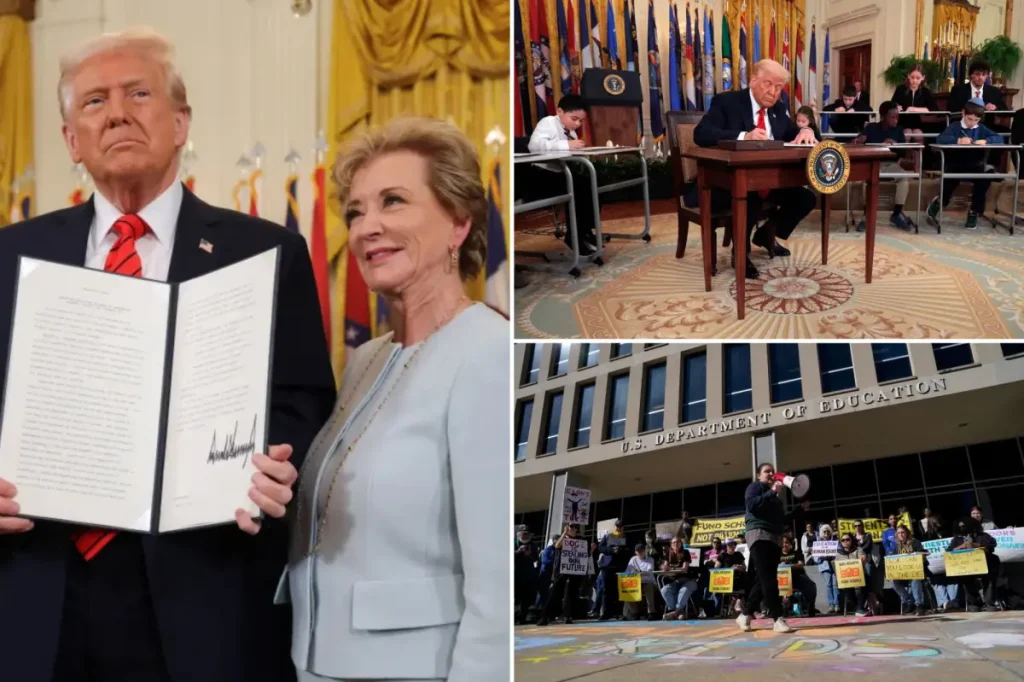Public Opinion Shifts on Department of Education Closure When Details Provided
A surprising new poll reveals that American voters’ stance on closing the Department of Education dramatically shifts when they understand the specifics of how such a transition would work. Initially, the concept faces resistance, but support grows substantially when voters learn about the preservation of educational funding and protections for vulnerable students.
According to a survey by the Yes Every Kid Foundation, when first asked about closing the Department of Education without context, 51% of registered voters opposed the idea, while 38% supported it. However, the numbers flipped dramatically when respondents learned key details: that K-12 funding would be preserved and essential functions would be merged with other agencies. With this information, support jumped to 56%, with opposition dropping to 30%. When provided even more details—including the gradual phase-out process, continued protections for students with disabilities, and statistics showing declining student achievement during the Department’s existence—support climbed further to 59%. Perhaps most notably, 56% of respondents indicated they would be disappointed if Congress blocked such efforts, suggesting that public opinion on this historically controversial proposal may be more malleable than previously thought.
The Department of Education, established in 1979, has become a focal point of President Trump’s second-term agenda, with his administration taking significant steps toward its eventual closure. Education Secretary Linda McMahon has already reduced the department by nearly half and begun consolidating key programs in preparation for a potential shutdown. “President Trump and Secretary McMahon are dedicated to improving education for our nation’s students—and that begins with empowering those who are closest to the child,” explained Madi Biedermann, a deputy assistant secretary at the department. The administration’s vision emphasizes “returning education to the states” by “removing unnecessary red tape and micromanagement by D.C. while maintaining critical funding for students with disabilities and low-income schools and continuing to protect students’ civil rights.”
Despite the administration’s determination, completely dissolving the Department of Education would require congressional approval. This presents a significant hurdle, as Republicans lack the 60 Senate votes needed to overcome the filibuster—a threshold that would necessitate Democratic support. In response to these legislative constraints, President Trump has taken executive action directing Secretary McMahon to wind down the department “to the maximum extent appropriate and permitted by law.” These efforts represent a strategic approach to achieve as much of the administration’s goal as possible within existing legal boundaries, while building public support for a complete transition.
The Yes Every Kid Foundation poll results stand in stark contrast to previous surveys that showed strong opposition to eliminating the Department of Education. For instance, a poll by PDK International earlier this year found that two-thirds of respondents opposed the department’s elimination. This disparity suggests that public opinion may be heavily influenced by how the proposal is framed and explained. When voters understand that the plan includes preserving K-12 funding, maintaining protections for vulnerable student populations, and transitioning responsibilities rather than simply eliminating them, their perspectives appear to shift significantly. This insight could prove valuable for policymakers on both sides of the issue as they craft their messaging.
The Department of Education currently oversees a substantial $268 billion budget, administering numerous programs affecting millions of American students. Critics argue that despite this massive investment, educational outcomes have declined over recent decades, with reading and math scores showing troubling trends. Supporters of the department’s closure suggest that transferring more control to states and local communities could lead to more innovative and responsive educational systems. The foundation’s survey, which sampled 1,500 registered voters with a nearly even split between Trump supporters (44%) and Harris supporters (42%), indicates that Americans across the political spectrum might be open to restructuring federal involvement in education when presented with a thoughtful transition plan.
This polling data reveals an important lesson about policy debates in America: how proposals are communicated can dramatically affect public reception. Rather than simple yes-or-no questions about complex issues, voters benefit from understanding the nuances and practical implications of major government reforms. As discussions about the Department of Education’s future continue, this survey suggests that Americans may be more willing to consider significant changes to federal education policy when they understand how those changes would be implemented and the protections that would remain in place for students and schools. The conversation has clearly moved beyond whether to close the department to how such a transition might be structured to preserve essential functions while potentially addressing longstanding concerns about federal effectiveness in education policy.










